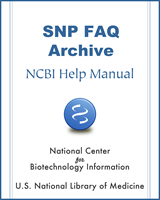NCBI Bookshelf. A service of the National Library of Medicine, National Institutes of Health.
SNP FAQ Archive [Internet]. Bethesda (MD): National Center for Biotechnology Information (US); 2005-.
This publication is provided for historical reference only and the information may be out of date.
Searching for SNPs Using Positional Data
Searching for SNPs Using EST Alignments
Searching for SNPs Using Positional Data
I have a SNP that has no rs number, but does have a ID (human TNF alpha -308G>T), I’ve searched in dbSNP, but can’t find an rs number for it.
Unless the submitter used the exact name "human TNF alpha -308G>T "in their submission, it won't show up as a result in your dbSNP search. It is also possible that the authors who mentioned "human TNF alpha -308G>T" in their publication never submitted this SNP to dbSNP.
Submission to dbSNP is voluntary, but we do try to encourage people to submit SNPs to dbSNP prior to publication so that they can cite their assigned dbSNP IDs (ss or rs) in their manuscript. Check the publication to see if the authors included a dbSNP ID for "human TNF alpha -308G>T" in the manuscript; if they have not, try BLASTing the DNA sequence of human TNF alpha -308G>T (if you have it) against dbSNP to see if there are any matching rs numbers. If there are no matches, and you wish to see this variation in dbSNP, you can submit it yourself using the Human Variation: Annotate and Submit Batch Data site (multiple submissions) or the Human Variation: Search, Annotate, Submit site(single submission). The HumanVariation Batch Submission Quick Start explains how it is possible to submit published SNPs not already housed in dbSNP. (04/30/08)
I am trying to find an rs number for a SNP called CD14-159C/T. Can you tell me what the rs number is or how I can find it?
You can use the Human Variation: Search, Annotate, Submit site to find the rs number you need, but you’ll need the accession number for the reference sequence that codes for CD14 to do so. (04/09/08)
How do I use Entrez SNP site to find the rs number SNP -308A/G located in the promoter region of the TNF-alpha gene (human)?
dbSNP has a new search resource called the Human Variation: Search, Annotate, Submit site, which uses names based on HGVS recommended nomenclature (e.g. NM_000594.2:c.-308G>A) that you can try, but you’ll need to have a accession for the reference sequence (a mRNA, or protein, or a genomic sequence in GenBank). (04/30/08)
Can you tell me how to find the rs number for a SNP when we have just position [TNFa (-308G/A) ] to search with?
Currently dbSNP does not support this kind of search; however, you can search SNPs within a gene using Entrez Gene. Add the filter "gene snp"[Filter] to your search term to retrieve genes containing SNPs (example: transporter AND "gene snp"[Filter]). Click on the blue word “Links” located to the right of each record, and select “GeneView in dbSNP” to view the dbSNP report. Please review the online help for additional Gene search terms and help.
dbSNP has a new search resource called the Human Variation: Search, Annotate, Submit site that uses names based on HGVS recommended nomenclature (e.g. NM_000594.2:c.-308G>A) that you can try, but you’ll need to have a accession for the reference sequence (a mRNA, or protein, or a genomic sequence in GenBank). (04/30/08)
Searching for SNPs Using EST Alignments
Do you know if there are tools for SNP discovery in the absence of genome sequence using multiple alignments of ESTs?
Gabor Marth wrote the program PolyBayes for that specific task. dbSNP has implemented PolyBayes as an internal tool for mining polymorphisms in genome pipeline activities. If you would like to use PolyBayes for a research project or within a research group, you should request both the program and a license to use the program from Gabor Marth. His contact email is ude.cb@htram. (2/10/05)
- Searching for SNPs Using Positional Data or EST Alignments - SNP FAQ ArchiveSearching for SNPs Using Positional Data or EST Alignments - SNP FAQ Archive
Your browsing activity is empty.
Activity recording is turned off.
See more...
